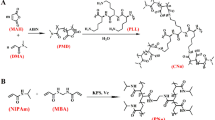Abstract
Poly(ethylene glycol)(PEG) macromers terminated with acrylate groups and semi-interpenetrating polymer networks (IPNs) composed of poly-ε-caprolactone(PCL) and PEG macromer were synthesized with the aim of obtaining a bioerodible hydrogel that could be used to release drugs for implantable delivery system. Polymerization of PEG macromer resulted in the formation of cross-linked gels due to the multifunctionality of macromer. Non-crosslinked PCL chains were interpenetrated into the cross-linked three-dimensions networks of PEG. The release of 5-fluorouracil(5-FU) from the IPNs increased with increasing PEG contents in the IPNs, large drug loading, lower concentration of PEG macromer in the IPNs concentration and the higher molecular weight of PEG macromer. Also, 5-FU was more fast released than hydrocortisone to the increased water solubility.
Similar content being viewed by others
References Cited
Chasin, M. and Langer, R., Biodegradable polymer as drug delivery systems, Marcel Dekker, New York, 1990.
Cho, C. S., Ha, J. H., Kim, S. H. and Kwon, J. K., Tetracycline release from bioerodible hydrogels based on semi-interpenetrating polymer networks composed of poly-ε-caprolactone and poly(ethylene glycol) macromer, submitted toJ. Applied Polym. Sci. (1994).
Domb, A., Ron, E. and Langer, R., Polyanhydries. II. One step polymerization using phosgene or diphosgene as coupling agents.Macromolecules, 21, 1925–1929 (1988).
Heller, J., Biodegradable polymers in controlled drug delivery, CRC Crit. Rev. Ther. Drug Carrier Syst., 1, 39–90 (1984).
Heller, J., Penhale, D. W., Fritzinger, B. K., Rose, J. E. and Helwing, R. F., Controlled release of contraceptive steroids from biodegradable poly(ortho esters).Contracept. Deliv. Syst., 4, 43–53 (1983).
Kulkami, R. K., Moor, N. G., Hegyelli, A. F. and Leonard, F., Biodegradable polylactic acid polymers.J. Biomed. Mater. Res., 5, 169–179 (1971)
Mauduit, J., Bukh, N. and Vert, M., Gentamycine/Poly (lactic acid) blends aimed at sustained release local antibiotic therapy administered per-operatively. I. The case of gentamycin base and gentamycin sulfate in poly(DL-lactic acid) oligomers.J. Controlled Release, 23, 209–220 (1993).
Negishi, N., Bennett, D. B., Cho, C. S., Jeong, S. Y., Van Heeswijk, W. A., Feijen, J. and Kim, S. W., Coupling of naltrexone to poly (α-amino acids).Pharm. Res., 4, 305–310 (1987).
Pitt, C. G., Chasalow, F. I., Hibionada, Y. M, Klimas, D. M. and Schindler, A., Aliphatic polyesters, I. The degradation of poly(ε-caprolactone)in vivo.J. Appl. Polym. Sci., 26, 3779–3787 (1981).
Pitt, C. G., Cha, Y. Hendren, R. W. Holloman, M. and Schindler, A., Manipulation of the permeability and degradation of polymers,Proc. 14th Int. Symp. Control. Rel. Bioactive Materials, 75–76 (1987).
Pitt, C. G., Gretzl, M. M., Kimmel, G. L., Surles, J. and Schindler, A., Aliphatic polyesters, II. The degradation of poly(DL-lactide), poly(ε-caprolactone), and their copolymersin vivo.Biomaterials, 2, 215–220 (1981).
Sperling, L. H.,Interpenetrating Polymer Networks and Related Materials, Plenum Press, New York, 1981.
Author information
Authors and Affiliations
Rights and permissions
About this article
Cite this article
Kim, SH., Ha, JH., Jung, YJ. et al. Drug release from bioerodible hydrogels composed of poly-ε-caprolactone/poly(ethylene glycol) macromer semiinterpenetrating polymer networks. Arch. Pharm. Res. 18, 18–21 (1995). https://doi.org/10.1007/BF02976501
Received:
Issue Date:
DOI: https://doi.org/10.1007/BF02976501




